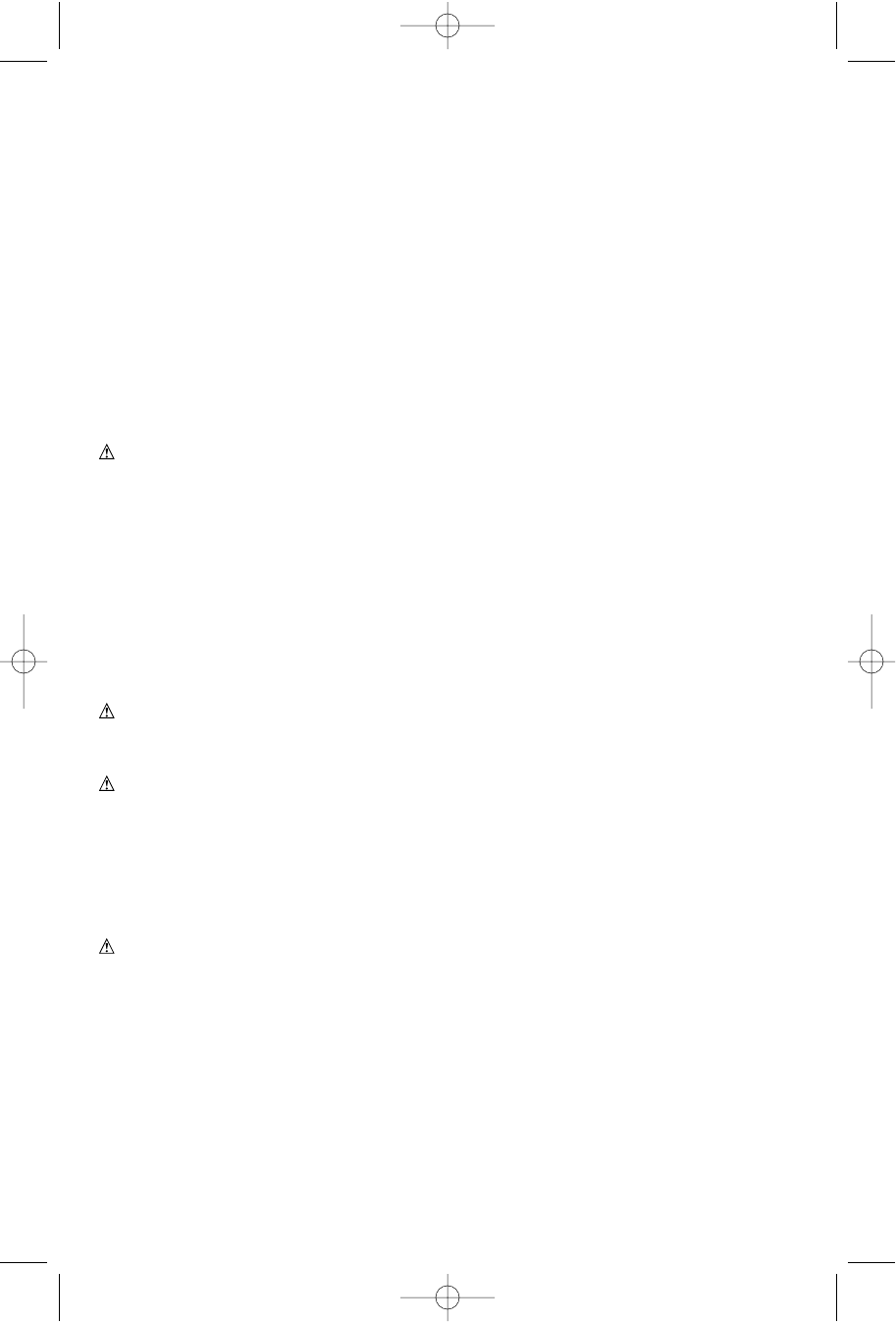
• When blade is binding or when interrupting a cut for any reason, release the trigger
and hold the saw motionless in the material until the blade comes to a complete
stop. Never attempt to remove the saw from the work or pull the saw backward
while the blade is in motion or KICKBACK may occur. Investigate and take corrective
actions to eliminate the cause of blade binding.
• When restarting a saw in the workpiece, center the saw blade in the kerf and check
that teeth are not engaged into the material. If saw blade is binding it may walk up or
KICKBACK from the workpiece as the saw is restarted.
• Support large panels to minimize the risk of blade pinching and KICKBACK. Large
panels tend to sag under their own weight. Supports must be placed under the panel on
both sides, near the line of cut and near the edge of the panel.
• Do not use dull or damaged blade. Unsharpened or improperly set blades produce
narrow kerf causing excessive friction, blade binding and KICKBACK.
• Blade depth and bevel adjusting locking levers must be tight and secure before
making cut. If blade adjustment shifts while cutting, it may cause binding and
KICKBACK.
• Use extra caution when making a "Pocket Cut" into existing walls or other blind
areas. The protruding blade may cut objects that can cause KICKBACK.
Additional Safety Rules: Circular Saws
WARNING: Some dust created by power sanding, sawing, grinding, drilling, and
other construction activities contains chemicals known to cause cancer, birth
defects or other reproductive harm. Some examples of these chemicals are:
• lead from lead-based paints,
• crystalline silica from bricks and cement and other masonry products, and
• arsenic and chromium from chemically-treated lumber (CCA).
Your risk from these exposures varies, depending on how often you do this type of work.
To reduce your exposure to these chemicals: work in a well ventilated area, and work
with approved safety equipment, such as those dust masks that are specially designed to
filter out microscopic particles.
• Avoid prolonged contact with dust from power sanding, sawing, grinding, drilling,
and other construction activities. Wear protective clothing and wash exposed
areas with soap and water. Allowing dust to get into your mouth, eyes, or lay on the skin
may promote absorption of harmful chemicals.
WARNING: Use of this tool can generate and/or disperse dust, which may cause
serious and permanent respiratory or other injury. Always use NIOSH/OSHA
approved respiratory protection appropriate for the dust exposure. Direct particles away
from face and body.
CAUTION: Wear appropriate hearing protection during use. Under some conditions
and duration of use, noise from this product may contribute to hearing loss.
• Snagging the lower guard on a surface below the material being cut can
momentarily reduce operator control. The saw can lift partially out of the cut increasing
the chance of blade twist. Ensure there is sufficient clearance under the workpiece.
• When necessary to raise lower guard manually, use the retracting lever.
• KEEP THE BLADES CLEAN AND SHARP. Sharp blades minimize stalling and kickback.
The use of dull and/or dirty blades can increase the saw loading causing the operator to
push harder which promotes twisting.
DANGER: KEEP HANDS AWAY FROM CUTTING AREA. Keep hands away from
blades. Never place hands in front of or behind the path of the blade while cutting. Do not
reach underneath work while blade is rotating. Do not attempt to remove cut material
when blade is moving.
• SUPPORT LARGE PANELS. Large panels must be supported as shown (Fig. E & F) in
this manual to minimize the risk of blade pinching and kickback. When cutting operation
requires the resting of the saw on the workpiece, the saw shall be rested on the larger
portion and the smaller piece cut off.
• USE ONLY CORRECT BLADES AND BLADE ASSEMBLY COMPONENTS WHEN
MOUNTING BLADES. Do not use blades with incorrect size holes. Never use defective
or incorrect blade washers or bolts. Follow blade assembly procedures.
• ADJUSTMENTS. Before cutting be sure depth and bevel adjustments are tight.
• SUPPORT AND SECURE THE WORK PROPERLY. Insure that the material to be cut is
clamped (Fig. G) and solidly supported and balanced on a strong, stable and level work
surface. Support the work so that the wide portion of the saw shoe is on the portion of the
material that doesn’t fall after the cut is made. Never hold cut off piece by hand (Fig. H).
4
90537965 BD Circ Saws 5/30/08 10:11 AM Page 4


















